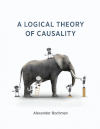- About MAA
- Membership
- MAA Publications
- Periodicals
- Blogs
- MAA Book Series
- MAA Press (an imprint of the AMS)
- MAA Notes
- MAA Reviews
- Mathematical Communication
- Information for Libraries
- Author Resources
- Advertise with MAA
- Meetings
- Competitions
- Programs
- Communities
- MAA Sections
- SIGMAA
- MAA Connect
- Students
- MAA Awards
- Awards Booklets
- Writing Awards
- Teaching Awards
- Service Awards
- Research Awards
- Lecture Awards
- Putnam Competition Individual and Team Winners
- D. E. Shaw Group AMC 8 Awards & Certificates
- Maryam Mirzakhani AMC 10 A Awards & Certificates
- Two Sigma AMC 10 B Awards & Certificates
- Jane Street AMC 12 A Awards & Certificates
- Akamai AMC 12 B Awards & Certificates
- High School Teachers
- News
You are here
A Logical Theory of Causality

Publisher:
MIT Press
Publication Date:
2021
Number of Pages:
366
Format:
Paperback
Price:
55.00
ISBN:
9780262045322
Category:
Monograph
[Reviewed by , on ]
P. Richard Hahn
03/20/2022
This scholarly volume recaps the author’s four decades of research on the formal logical analysis of causation. Special emphasis is placed on comparing and contrasting the author’s approach to associated work in philosophy, mathematical logic, computer science, artificial intelligence, and even law. The early chapters of the book are particularly thorough at drawing out connections to earlier ideas, reaching as far back as ancient Greece, on through Hume and Mill, and into the present day. The first half of the book is devoted to laying the groundwork for the author's logical theory of causality, while the second half turns to various extensions of the theory, including the difficult case of so-called “actual causality”.
This book is not a textbook. Although the author’s theory is developed from the ground up, with formal definitions and examples constituting a large part of the text, the reader is expected to be fluent in the terminology and methods of formal logic, and completely at ease with fundamental conceptual distinctions in that field, such as that between model theoretic approaches and proof theoretic approaches and that between monotonic and non-monotonic logics, for example. Prior exposure to the philosophical literature on causation would be a definite plus in providing context for many of the scholarly asides. At the same time, proofs of some key results are not reproduced; interested readers are instructed to consult the original papers.
The book does not engage with the field of causal inference and data analysis (meaning topics such as treatment effect estimation and mediation analysis). This omission is striking because large sections of the book are devoted to establishing connections to the work of Judea Pearl, whose seminal work in artificial intelligence and causality has come to influence contemporary data science. Similarly, the logical framework described in the book is related to prior conceptions of causality arising in econometrics. But whereas those lines of research can be brought to bear on applied empirical problems, the author’s logical framework appears to have no straightforward application to that setting. In terms of real-world applications, the main use case seems to be in law, providing a formal foundation for an approach articulated in the middle of the last century by Hart and Honoree. Even here, the main thrust seems to be to provide formal justification for intuitions or frameworks already in practice rather than to generate novel causal analyses (this is perhaps typical of treatments of causality in the philosophy literature).
By painstakingly situating the new theory at the intersection of several distinct intellectual traditions, the key ideas forming the new theory can be hard to trace out. Given the interesting topic and the author’s clear authority and wide knowledge, a streamlined version of the theory would be most welcome. But it is unfair to criticize a book for not being a different book. For a certain reader, A Logical Theory of Causality provides a rich collection of ideas to be chased down and chewed over. In this sense, the ideal reader would be a graduate student in formal logic looking to understand how the concept of causality can be understood through that lens. For this audience, the bibliography alone is an incredible resource, and the many illuminating examples, particularly in the latter half of the book, promise to be an endless source of inspiration.
P. Richard Hahn is an associate professor of statistics at Arizona State University.
See the publisher's website.
- Log in to post comments




